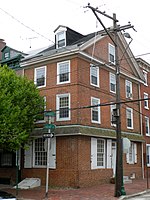The 1834 Philadelphia race riot, also known as the Flying Horses riot, was an instance of communal violence in Philadelphia, Pennsylvania, United States. The riot, in which a mob of several hundred white people attacked African Americans living in the area, began on the evening of August 12 and lasted for several days, dying down by August 14.
The riot took place during a time when many cities in the northern United States were experiencing incidents of mass civil disorder, usually in the form of riots that targeted specific religious, national, or racial groups, such as an 1831 race riot in Providence, Rhode Island, and the 1834 Ursuline Convent riots near Boston. In Philadelphia, this period coincided with a significant growth in population, particularly among African Americans and Irish immigrants. While there had been a strong community of working class black freedmen in Philadelphia since the early 1800s, tensions began to build through the 1830s, with restrictions on African Americans' participation in civic life and incidents of racial violence, such as in an 1829 incident where members of a black church were attacked. In early August 1834, there were several instances of violence against African Americans in the city, including an attack on the son of well-known black businessman James Forten by a white mob.
On August 12, 1834, a mob of several hundred white men, primarily Irish, attacked the Flying Horses tavern, a well-known local on South Street that served both black and white people in the area, named for a popular carousel on site. The mob overpowered the black people there, destroyed the carousel and building, and proceeded down South Street and into Moyamensing, where they proceeded to destroy black-owned buildings and attack black people. Philadelphia Mayor John Swift assembled a posse of several hundred citizens to restore order, and 18 people were arrested, but rioting commenced again the following night, resulting in the destruction of the African Presbyterian Church and the beating to death of an African American man. The next night was the last major night of rioting and saw the destruction of another church, though some minor instances of violence continued for the next few nights. In general, rioters targeted the houses of more wealthy African Americans and social spaces, such as churches and a Masonic Hall. In total, between August 12 and 16, 60 people were arrested for rioting. In the end, 44 buildings had been destroyed, including 30 houses, and 2 people were dead.
A citizen's committee organized to investigate the causes of the riot reported that the primary cause was a sense of anxiety among white citizens who believed that black people were out-competing them for jobs. This conclusion has been discussed by historians, who also attribute the riot to fears over interracial mixing and resentments held against more affluent African Americans by poor whites. Over the next several years, Philadelphia experienced a wave of race riots, including one the following year and the 1838 destruction of Pennsylvania Hall. Discussing this time period, local author Charles Godfrey Leland wrote, "Whoever shall write a history of Philadelphia from the Thirties to the era of the Fifties will record a popular period of turbulence and outrages so extensive as to now appear almost incredible". By 1854, in part due to the riots, the county and city of Philadelphia were consolidated and a new police agency was created.








